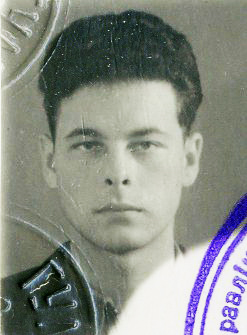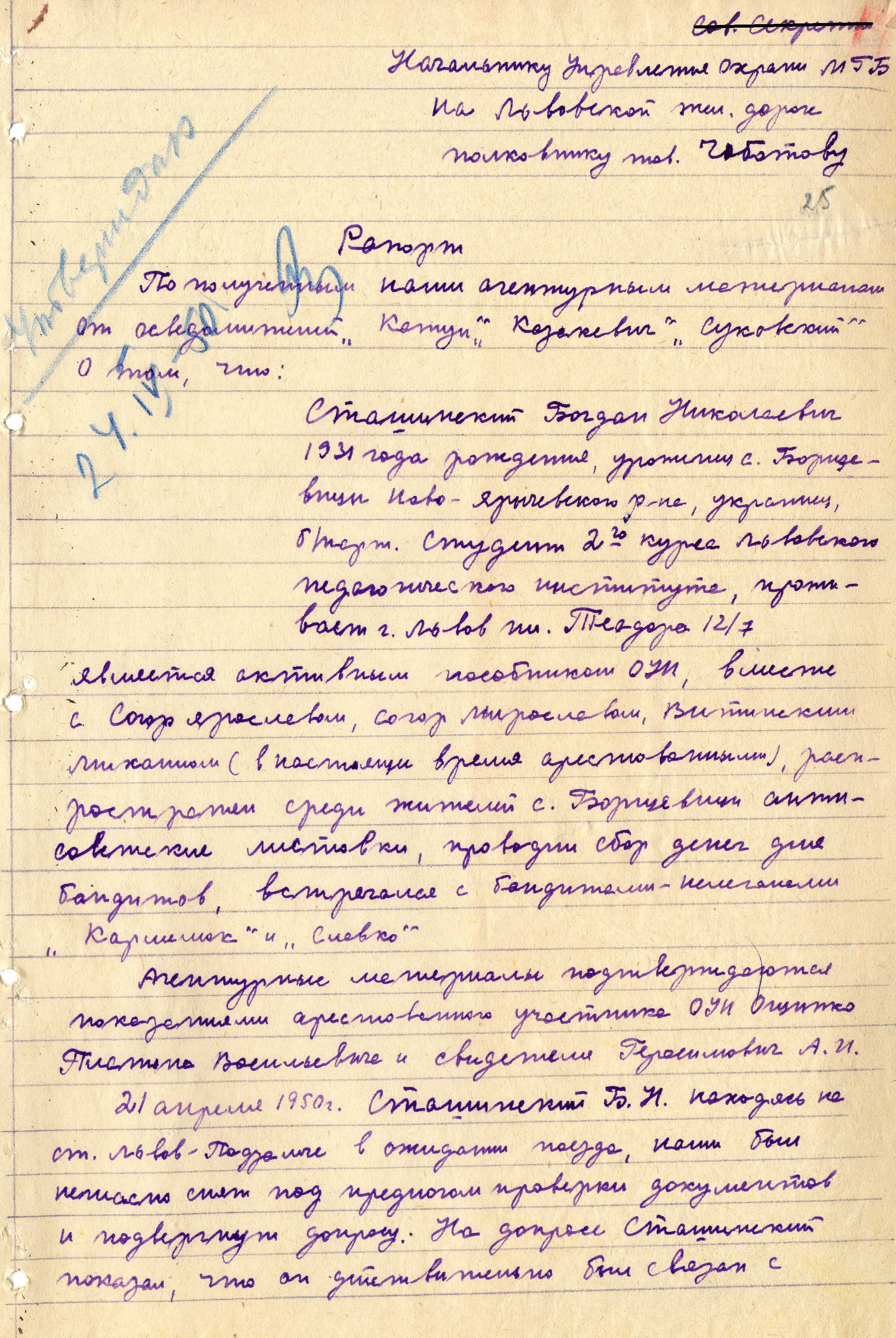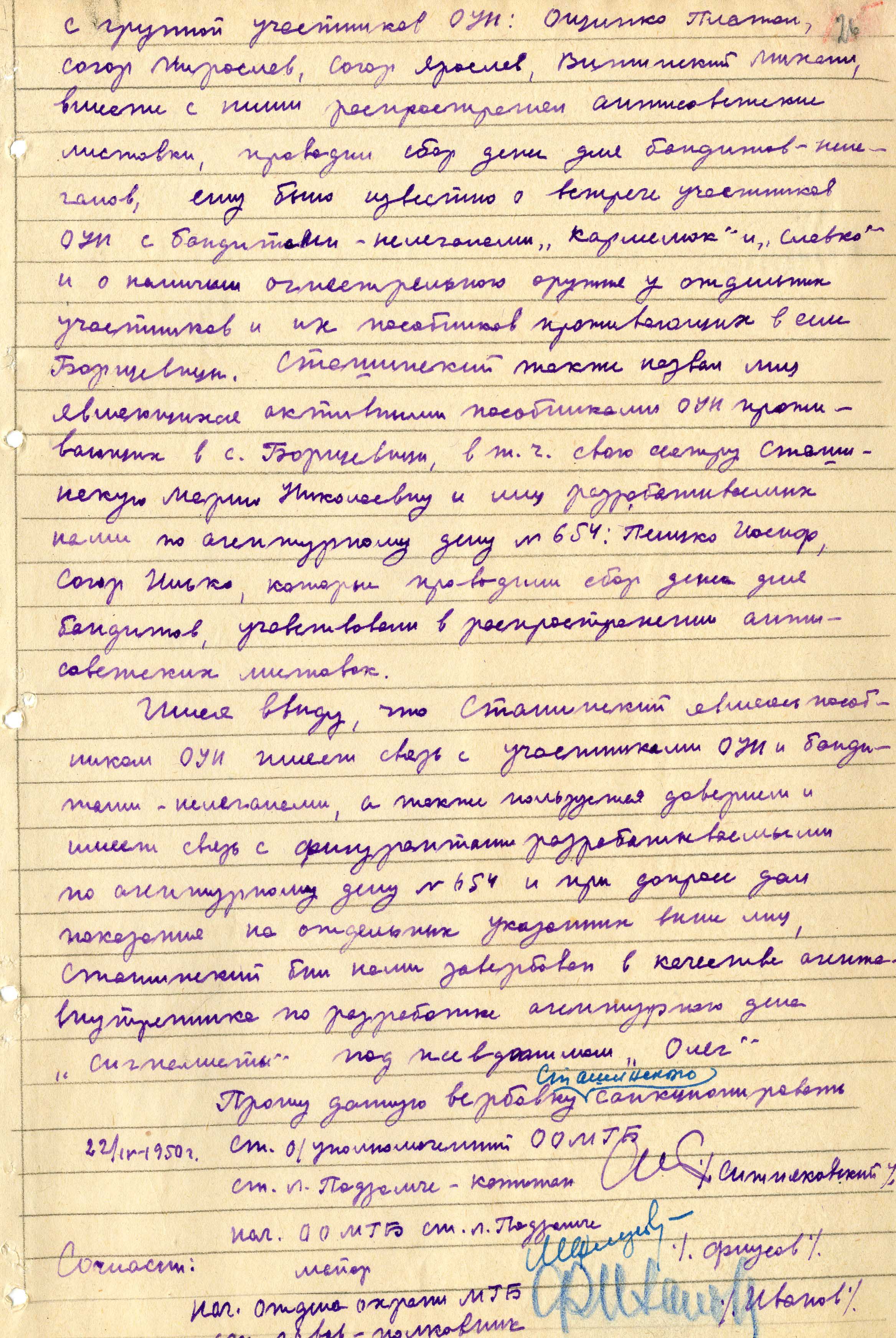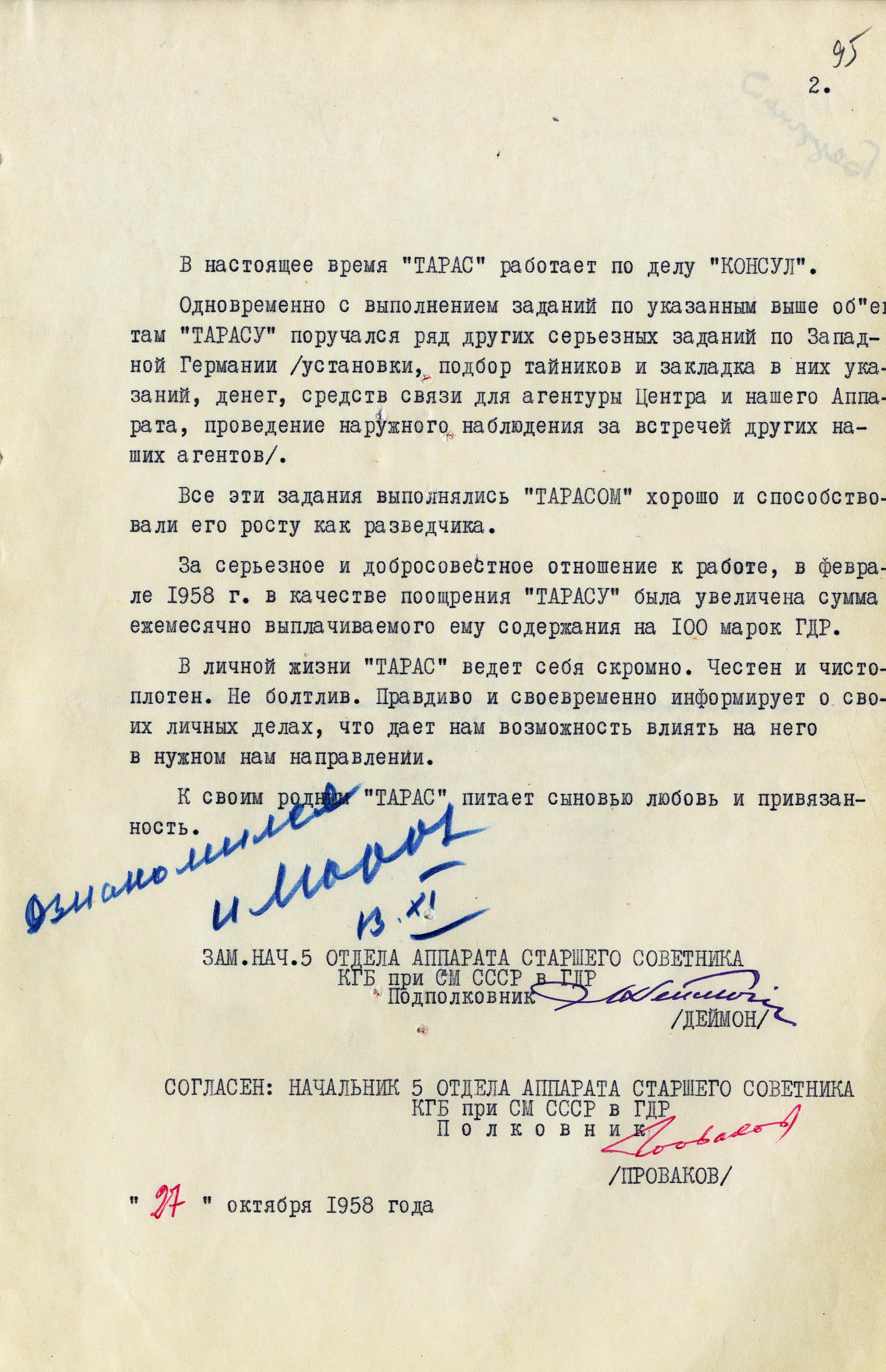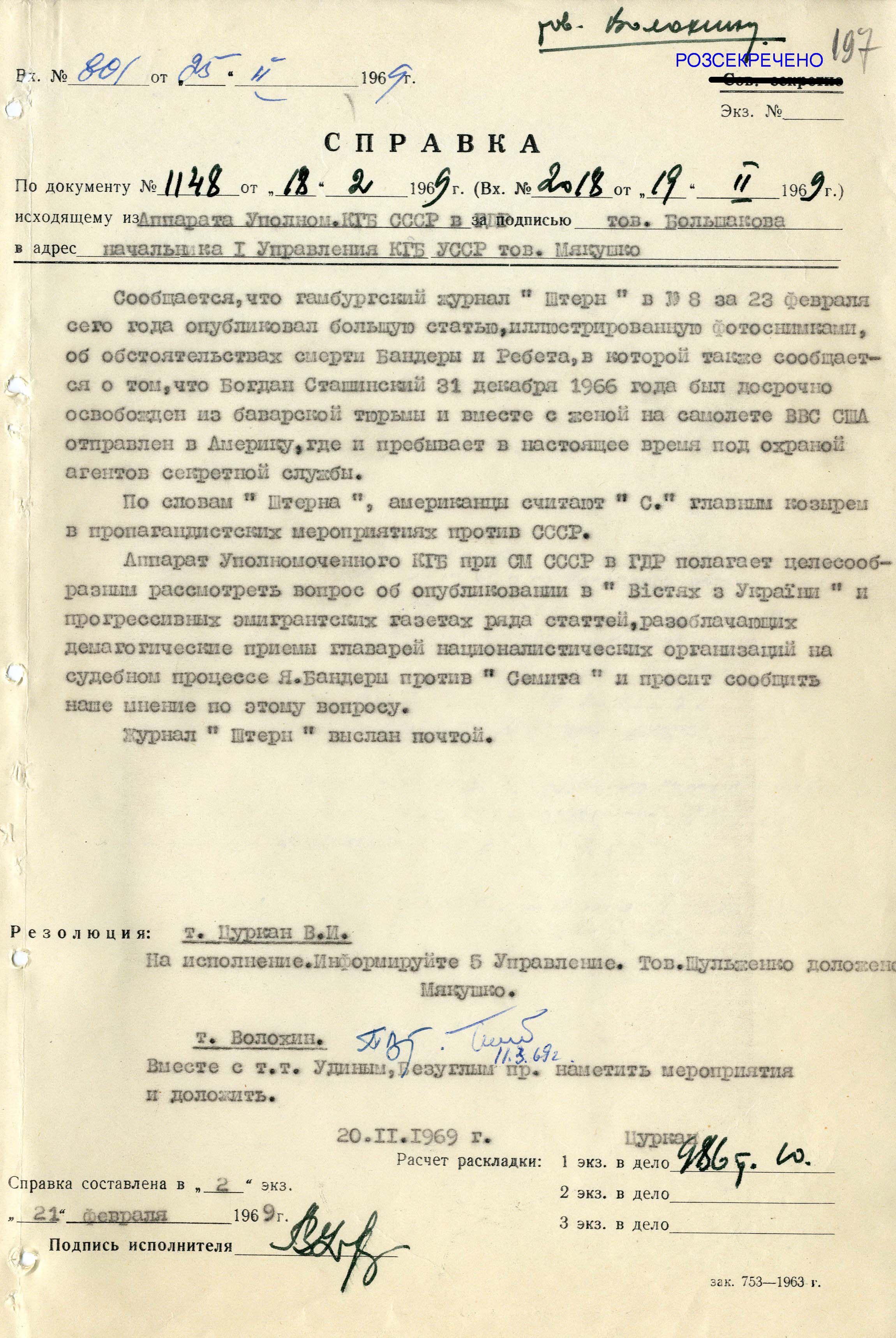Bohdan Stashynskyi. Assassinations. Post Scriptum
10/12/2023
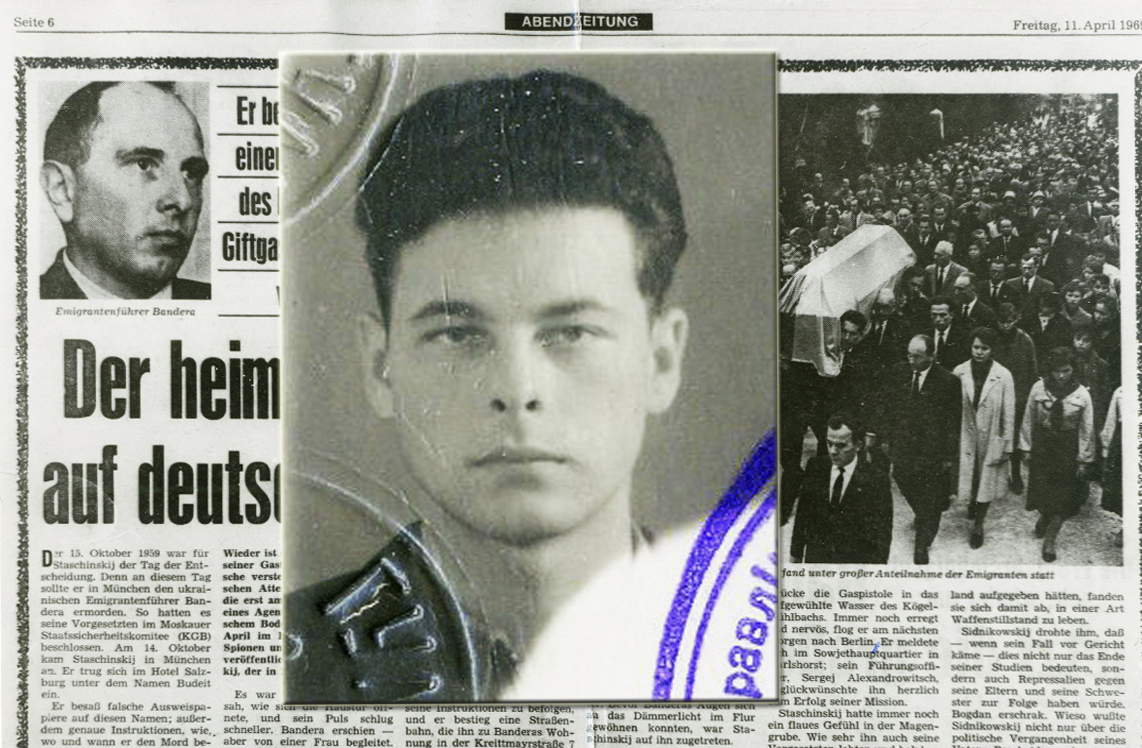
On October 12, 1957, kgb agent Bohdan Stashynskyi killed Ukrainian politician and publicist Lev Rebet in Munich, and on October 15, 1959, OUN leader Stepan Bandera. In October 1962, a court in the German city of Karlsruhe sentenced the perpetrator of these crimes and condemned the organizers – soviet special services led by the kremlin leadership. Many articles, books, and monographs have been written about these political assassinations and the course of the trial. At the same time, a thorough study of declassified documents from the archive of the Foreign Intelligence Service of Ukraine makes it possible to find out the hitherto unknown details of those high-profile events and correct some traditional interpretations.
The Myth of Recruitment for Ticketless Travel
Until now, all publications have been retelling the story that on April 21, 1950, Bohdan Stashynskyi, a student of the Lviv Pedagogical Institute, was detained on the train by a train conductor (or militiaman) on the way from Lviv to his native village of Borshchovychi for traveling without a ticket. According to one of the common versions, the train conductor allegedly handed the “hare” over to the railway militia, whose officer conducted a preventive conversation and immediately recruited a 19-year-old boy. According to another, the student was shamed and released, but a few days later a man in civilian clothes came to his house and invited him to the railway militia department, which was then part of the mgb. During the conversation, the officer made an offer which could not be refused: cooperation in exchange for freedom for Bohdan and his family, or exile of the whole family to Siberia for 25 years.
This version of the story of his cooperation with the mgb of the ussr was told by B. Stashynskyi himself at the trial. So it is not surprising that it was immediately picked up by the press, and was never changed in all further publications. It turned out that it was that unfortunate incident that played a key role in his life and in history in general. But was that detention a coincidence? Did he have a ticket then? Why did he use this interpretation to describe the circumstances of his recruitment?
The answers to these questions are in the documents from the operational case against B. Stashynskyi. They say that at the beginning of 1950, the mgb received information about the distribution of anti-soviet leaflets in the village of Borshchovychi. A number of residents were suspected of involvement in this, as well as in fundraising for the OUN underground during the Christmas holidays. Among them was B. Stashynskyi. All of them were taken into the intelligence department in the case of “Signalmen”' and were studied.
Soon, B. Stashynskyi, who was very active in carrying out these actions, was singled out among the suspects. In addition, it was found out that his father and sisters maintained contacts with the OUN underground, for which in the past they were arrested by the mgb and held in custody for some time. Bohdan was the only child in the family who was getting a higher education, the family was proud of him, they hoped that he would study and have a good job. He himself aspired to this and cherished his status very much. These were the “trump cards” that were supposed to play during the recruitment.
On April 20, 1950, Captain Sytniakovskyi, a senior operational officer of the mgb security department at the Lviv-Pidzamche railway station, received the following written instruction from his bosses: “As for Bohdan Stashynskyi, it is necessary to resolve the issue of his recruitment as an agent for cultivation of persons involved in the intelligence case, since he has ties with them”(BSA of the SZR of Ukraine. – F. 1. Case 237. – Vol. 1. –P. 31).
Besides, it was found out that on weekends, B. Stashynskyi usually travelled home from Lviv with a briefcase filled with some papers. It was assumed that this was where the leaflets could be. So in the evening they were already waiting for him at the station. Captain Sytniakovskyi described further events in his report as follows:
“On April 21, 1950, B.M. Stashynskyi, while waiting for the train at the station Lviv-Pidzamche, was illegally detained by us under the guise of checking documents and subjected to interrogation. During the interrogation, Stashynskyi testified that he was indeed connected with a group of OUN members Platon Oshchipko, Myroslav Sohor, Yaroslav Sohor, Mykhailo Vitynskyi, together with them he distributed anti-soviet leaflets, was fundraising for illegal bandits, he knew about the meeting of OUN members with illegal bandits “Karmelyuk” and “Slavko” and that individual participants and their accomplices living in the village of Borshchovychi had firearms. Stashynskyi also named the persons who are active collaborators of the OUN living in the village of Borshchovychi, including his sister Maria Mykolayivna Stashynska, and the persons who are being cultivated by us in the case...” (BSA of the SZR of Ukraine. – F. 1. Case. 237. – Vol. 1. –P. 25–26).
At the end of the report, it is pointed out that after all these confessions, B. Stashynskyi was recruited “as an internal agent in the investigation of the case “Signalmen” under the code name “Oleh”.
The file also contains the record of B. Stashynskyi’s interrogation, which began on April 21 at 9:30 p.m. and ended on April 22 at 1:30 a.m. That is, the interrogation lasted four hours. There is no information about threats with Siberia and expulsion from the institute in the interrogation protocol. Although they should not be ruled out. At the same time, in the description of the agent, dated February 7, 1951, it is noted that he “willingly agreed to recruitment”.
There is no detailed information in the case file about other persons with whom B. Stashynskyi distributed leaflets and fundraised money, and about their further fate at that time. Only documents from the 1960s about some of them mention that they returned to the village after exile to Siberia.
But where did the version of ticketless travel come from? One of the papers on B. Stashynskyi, dated February 4, 1952, that is, almost two years later, states as follows:
“On the night of January 28-29 this year, agent “Oleh” was traveling from Zabolottia district to Lviv by train without money and without documents. The train conductor detained him as a person traveling without a ticket and handed him over to a militiaman. “Oleh” told the latter, that he worked in the mgb operational group, referred to the name of the head of the operational group, after which the militiaman let him go and instructed the train conductor to take him without a ticket. (BSA of the SZR of Ukraine, F.1, Case 237. – Vol. 1. –P. 135).
Apparently, during his testimony in court, B. Stashynskyi decided that the version with coercion to cooperate with the mgb after detention for traveling without a ticket and further threats would be more beneficial. This was supposed to make him in the eyes of judges a victim of stalin's special services and a person who took such a step to protect his family from repression.
Discrediting Cannot Be Justified
The following volumes of the case tell about B. Stashynskyi's preparation for performing tasks, his infiltration into the OUN underground, his staying in kryivkas (military-defense and economic structure of the Ukrainian Insurgent Army; hideout; bunker;- Transl.), the routes of the insurgents' going on missions, the hiding places of Providnyk “Karmeliuk” – the fiancé of his sister Maria. In the messages, he showed considerable initiative during the fulfillment of tasks and even suggested that he could eliminate the insurgent unit in which he was at that time with his own weapons. But the chekists did it themselves, allowing the agent to be the only person who allegedly escaped.
Many documents are devoted to the preparation of agent “Oleh”, whose code name at that time was changed to “Taras”, before he was sent abroad to perform special tasks. There are no direct materials (plans, written assignments, instructions, reports) related to the murders of Lev Rebet and Stepan Bandera by B. Stashynskyi in the declassified file. They were developed in moscow and in the branch of the kgb of the ussr in the German Democratic Republic, from the positions of which the kgb sent the agent to Munich, kept in touch with him, and coordinated all his work.
But then, all this is described in detail in numerous publications, including B. Stashynskyi's escape to West Berlin, his confession and the trial itself, which took place from October 8 to 19, 1962 in the German city of Karlsruhe. It also became public how the kgb, trying to somehow cover up its failure, decided to conduct a large-scale campaign to disinform the world community.
At the same time, no less interesting and important is the information that went unnoticed. In particular, about how the kgb tried to distance itself from B. Stashynskyi and portray him as a kind of bandit and enemy of the soviet government, what measures it took to deceive his parents and fellow villagers and in general to prevent conveying the truth from the courtroom to Ukrainians.
As early as August 19, 1961, an instruction was received from moscow addressed to the chief of the kgb under the council of ministers of the Ukrainian ssr, vitaliy nikitchenko. It read that on August 12, agent “Taras” disappeared from the democratic sector of Berlin. Further, it was proposed “on the basis of the information available in the cases on the agent to prepare well-reasoned material that could compromise him as an OUN bandit who escaped from soviet justice and is used by foreign intelligence for its own subversive purposes. It is proposed to use this document in case if “Taras” begins to make some anti-soviet statements” (BSA of the SZR of Ukraine. – F. 1. Case 237. – V. 6. –P. 170).
In pursuance of this instruction, a large report was indeed prepared on the anti-soviet activities of B. Stashynskyi and his close relatives, participation in the armed underground, struggle against the soviet government, etc. For this purpose, written testimony was taken from eyewitnesses and convicted persons. In this regard, one of the papers addressed to moscow stated: “In case if some witnesses make statements that they saw “T” in the village in 1960 with his German wife and tell other information about him that is unfavorable to us, explain to such persons during interrogation that “T” is a criminal who is hiding and is wanted by soviet authorities” (BSA of the SZR of Ukraine. - F. 1. Case 237. – V. 6. –P. 216).
Separate activities were also planned to work with the father. Here everything was more complicated. After all, he knew that his son had been associated with the MGB/KGB for many years and carried out some tasks on their instructions. Back then, in the early 1950s, state security officers met with the father, explained to him that his son was engaged in important work in the interests of the state, and said that he could be proud of him. Besides, he had been paid 400 rubles a month first delivered by an officer, and then through the post office as assistance from his son from his salary, and wrote receipts about it.
Therefore, it was assumed that his father would insist that Bohdan worked for the kgb. In this case, it was planned to explain to him that he “had long been associated with foreign intelligence services and had been used by them for purposes hostile to the soviet union, and everything he told him about his connection with us should be considered his despicable lies”.
These plans and proposals, set out in operational documents, received a negative response from moscow. The letter reminded that in 1959 B. Stashynskyi came to the village and told his father about awarding him with the order of the red banner. Therefore, it was advised not to talk about him as a criminal hiding from the soviet authorities, because “this can lead to the fact that his father will believe that it was Stashynskyi who killed Bandera”. As for the order, it was recommended to explain that he “carried out an important assignment for the national economy of our country and that “Taras” never worked against Ukrainians”.
At the same time, the kgb took measures to prevent the leakage of any information about B. Stashynskyi and his family. For this purpose, they reviewed and filtered all correspondence that came out of Borshchovychi and surrounding villages. On the other hand, they raised the issue of blocking channels of information from abroad about B. Stashynskyi's confession to the murders of L. Rebet and S. Bandera. They tried to block this information getting both to Borshchovychi and to the Ukrainian ssr in general.
His parents' house and the flat of his sister Iryna who lived in Lviv, were searched. The relatives were instructed to burn all letters that came from Bohdan and receipts for money transfers.
In December 1961, moscow developed an action plan to localize the negative consequences of B. Stashynskyi's escape abroad. An excerpt from it was sent to Kyiv. It said that from the position of the central apparatus of the kgb “a number of measures have already been taken to discredit West Germany’s intelligence as the organizer of the murder of Bandera. In particular, press conferences were held in Berlin with the participation of our agent “Lyuks” and our German friends’ agent “Hausmann”, at which West German intelligence, in addition to the liquidation of Bandera, was also charged with the murder of Algerian patriots... The materials of the press conferences of “Lyuks” and “Hausmann” were published in the communist, progressive émigré press and in part of the bourgeois one in the USA, Canada, France, Norway, Finland, Italy, Belgium, Brazil, and the UAR” (BSA of the SZR of Ukraine. – F.1, Case 237. – V. 6. –P. 283).
The task was to publish the materials of these and other press conferences of kgb agents in separate brochures abroad. In them, the blame for the murders of Ukrainian activists was deliberately placed on foreign intelligence services, and then – on persons from the environment of OUN leaders, which was refuted by the investigation and the OUN leadership even before the trial. It was planned to publish abroad books and excerpts from them that would discredit prominent figures of the Ukrainian national liberation movement. They also spread in the media the speeches of OUN emissaries detained on the territory of the ussr, which they wrote under the dictation of kgb officers. The publication of such propaganda materials abroad was not cheap. But no money was spared for this.
One of the points of the plan instructed “within a month, to document the criminal activity on the territory of Ukraine during the Second World War of the leaders of the OUN Lenkavskyi, Vaskovych, Stetsko, Lebid, Lopatynskyi”. The response from Kyiv stated: “We have faced significant difficulties in documenting the OUN leaders’ criminal activities on the territory of Ukraine during the Second World War. We will not be able to obtain the necessary documentary materials and testimonies of persons regarding Lenkavskyi, Vaskovych, and Stetsko as war criminals” (BSA of the SZR of Ukraine. – F. 1. Case 237. – V. 6. –P. 334).
Of course, such materials did not exist. Nothing could be found on other persons either. At the same time, the kgb under the council of ministers of the Ukrainian ssr promised to look for and come up with something. Where it came to “inventing” and “fabricating”, the kgb had quite a few methods.
At the same time, moscow recommended not to allow to publish any materials on B. Stashynskyi’s case in the soviet press and on the radio, so as not to provoke anti-soviet sentiments among the population. That is, this event should have been hushed up. Measures were also taken to prevent foreign press from entering the territory of the Ukrainian ssr with reports about this trial.
A report from Kyiv to moscow dated February 24, 1962, stated: “We have taken measures to confiscate all Ukrainian nationalist press, newspapers, magazines, bulletins, etc., as well as letters with newspaper clippings with provocative messages enclosed in them. The issues of those Ukrainian progressive newspapers that come to the republic and contain articles and reports on B. Stashynskyi’s case, are also subject to control and destruction”(BSA of the SZR of Ukraine. – F. 1. Case 237. – V. 6. – P. 334).
Further, the document specifies that 374 copies of the newspaper “Homin Ukrainy” of December 9, 1961 and 50 copies of the newspaper “Ukrainske Zhyttya” (“Voice of Ukraine” and “Ukrainian Life”, respectively- Transl.) of November 22, 1961, which were published in Canada and sent to individual Ukrainian citizens, village councils, newspaper editorial offices, and educational institutions, were seized. “Destroyed by the Lviv point “PK” – this is how it was reported about their fate.
The paper of the kgb directorate under the cabinet of ministers of the Ukrainian ssr in Lviv region dated November 20, 1962, lists the measures that were taken to prevent information about the trial from entering the region from abroad. They included the seizure of a number of German newspapers with reports from the courtroom, not letting (through the visa and registration department) foreign citizens visit Novyi Yarychiv district, which then included Borshchovychi, thorough inspection of citizens' belongings at border control points, and seizure of materials about B. Stashynskyi.
There was another channel for obtaining truthful information about B. Stashynskyi’s case – the programs of the “Voice of America” and “Radio Liberty”'. The kgb under the council of ministers of the Ukrainian ssr asked moscow to take additional measures to completely jam those radio stations. moscow replied that it was technically difficult to do. As a result, some information still reached the residents of Borshchovychi. In the above-mentioned paper from Lviv, it was reported that many residents of the villages of Borshchovychi and Pikulovychi knew about the trial from foreign radio broadcasts.
There are a number of intelligence reports about such facts in the case. In particular, it is noted that on October 10, 1962, in the repair shop, former members of the Ukrainian nationalist underground “discussed the trial of Stashynskyi, about which they learned from the radio broadcasts of Western radio stations”. On October 9, 1962, “in A.V. Bodnar’s flat, they listened to a program of a foreign radio station about the trial of Stashynskyi. At that, Bodnar A.V. stated: “Lord, let the power change, he (meaning Stashynskyi's father) would be punished for the murder of Bandera. He brought up such a scoundrel”. Another excerpt from the report says that “the house of Stashynskyi's father was visited by the nationalist Yaroslav Sohor, who returned from exile, and made a scandal, accusing the father of raising such a son who killed Bandera” (BSA of the SZR of Ukraine. – F. 1. Case 237. – V. 7. –P. 121–122). It was the same Y. Sohor, about whom B. Stashynskyi reported during a recruiting conversation, that he also participated in the distribution of anti-soviet leaflets.
At the same time, kgb officers decided to take a strange position in their work with the father. One of the action plans stated: “If the father of “Taras” asks us for clarification regarding the information about his son, explain to him that we know about it all only from the programs of “H.A.” (“Voice of America”- Transl.), doubt the veracity and in case of receiving any information about him, we will immediately inform him” (BSA of the SZR of Ukraine. – F. 1. Case 237. – V. 6. –P. 233). In the future, they decided not to tell the father anything, not to meet with him and not to persuade him of something, “because it may cause the opposite reaction”.
The kgb, together with the party bodies, also took measures to publish in the newspapers “Golos Rodiny”, “Visti z Ukrainy” and others, which were distributed abroad, materials specially prepared for this purpose in the offices at the Lubyanka.
In its issue of November 15, 1962, the émigré newspaper “Ukrainska Dumka” reacted to one of those articles as follows: “The kgb’s bait “Golos Rodiny” in Issue 80 (October 1962). published false information that the moscow criminal Stashynskyi, sentenced to 8 years in prison, was not a soviet citizen, but a person framed by the OUN, and that the trial in Karlsruhe was a “comedy” arranged by German officials together with the Organization. It is necessary to keep an eye on who and what press are spreading this bolshevik provocation and who is helping the moscow murderers in their intelligence work with this propaganda”.
There are many such excerpts from émigré newspapers, reactions to the trial, reports of protest meetings against the kgb’s crimes against Ukrainian figures abroad in the materials of the archival case. But such information did not go beyond the offices of the kgb and the central committee of the cpsu. An official tass report was prepared for the general public. It was recommended as guidelines in the work. The instructions prepared in moscow on this matter read:
“It seems expedient to us to orient the operational staff of the kgb in the western regions of Ukraine and, above all, in Lviv region, so that each agent from whom reports about “Taras” are received, should be explained on the basis of a tass report (pravda of 16.11. this year) that the information of “H.A.” is a provocation of the enemy aimed at deceiving the public... Such agents should be focused on countering rumors about “Taras” and exposing them as provocative. It is not yet necessary to orient to this the agents who do not report about “Taras” (BSA of the SZR of Ukraine. – F. 1. Case 237. – V. 6. –P. 243).
Who Else Could Have Become B. Stashynskyi’s Victim?
The study of archival documents shows that Lev Rebet and Stepan Bandera were not the only ones in respect of whom B. Stashynskyi fulfilled the tasks set by his curators. For example, in the description of the agent, dated October 27, 1958, it is noted that “in 1957, after “Taras” had become well acquainted with the situation in the West and had gained the necessary experience in intelligence work in West Germany, he successfully performed a task, for which he was rewarded by the kgb under the council of ministers of the ussr (3,000 rubles) and by a senior adviser to the kgb under the council of ministers of the ussr in the GDR (3,000 marks of the GDR)” (BSA of the SZR of Ukraine. – F. 1. Case 237. – V. 6. –P. 94).
From other sources it is known that for the murder of Lev Rebet on October 12, 1957, B. Stashynskyi was awarded only a camera. And at the trial, in his testimony, he denied receiving any monetary reward after that assassination. That is, those considerable cash prizes were given as an incentive for completing some other task. But we don’t know what task it was.
The case file also mentions that B. Stashynskyi received an assignment from his handlers to find out Yaroslav Stetsko’s place of residence in Munich, his habits, daily routine, etc. At the same time, according to the agent himself, he never received the kgb’s order to kill Stetsko.
Participation in other similar operations is not mentioned in the case file. Only in Volodymyr Stakhiv's brochure “The Trial Against B. Stashynskyi” (Prologue Publishing House, New York, 1962), attached to the case, there is a mention that during the trial, B. Stashynskyi told about communication with his kgb handlers in moscow at the end of 1959 on the eve of receiving the order of the red banner. In Stashynskyi’s own words, he was told by the chief of the department Aleksey Alekseevich that “I will continue to work as I have for the last three years and that I will be carrying out assassinations”.
That is, the list of B. Stashynskyi's victims could have been longer.
P.P.S. Mysterious Disappearance
The sentence was pronounced by the Federal Court of Karlsruhe on October 19, 1962. At that time, it was already known about the deployment of nuclear weapons by the Soviet Union in Cuba and about the threat of their use. This was one of the most tense moments of the Cold War and ideological confrontation. But the so-called Cuban Missile Crisis could no longer influence the court's decision. Even without this, enough evidence was collected and all those responsible for the preparation for high-profile political assassinations, their planning and performance were identified.
The court ruled that the main guilt was borne by the communist leadership of the Soviet Union. Yaroslav Stetsko, who was present at the trial, in his testimony accused Nikita Khrushchev personally of those murders and called for the case to be transferred to an international tribunal. In this light, B. Stashynskyi was considered as a tool in the hands of real criminals and only as an executor of criminal orders. He was sentenced to 8 years in prison.
Subsequently, operational measures against him never stopped. One of the documents, dated January 1963, which came from moscow to Kyiv, states that “Taras”, according to information from foreign sources, is being held in one of the West German prisons, but its name is carefully concealed. “According to available information”, the document continues, “the counterintelligence agencies of Germany have also taken measures to keep the whereabouts of “Taras”' wife, Inga, Paul, secret for a number of years. In order to seek “Taras” and find out his whereabouts, we consider it expedient to continue measures for the intelligence cultivation of his relatives in the ussr” (BSA of the SZR of Ukraine. – F. 1. Case 237. – TV. 7. –P. 134).
A year later, moscow asked for information on what was new in the case of B. Stashynskyi, who was given a new code name – “Skorpion”. The kgb under the council of ministers of the Ukrainian ssr reported that close relatives were under surveillance. In particular, they quoted the statements of Bohdan’s sister Maria, who in the autumn of 1963 in the presence of women – collective farmers stated: “We have remained the same as we were, we are not responsible for our brother's actions, we did not send him there”. According to one of the operational sources, “In April 1964, B. Stashynskyi's father told that his son, who was held in one of the prisons in West Germany, was released and is now allegedly in moscow. The aim of “Skorpion”’s father’s spreading such rumors has yet to be found out” (BSA of the SZR of Ukraine. – F. 1. Case 237. – V. 7. –P. 156).
In fact, B. Stashynskyi was released early on December 31, 1966, four years after the court verdict. The office of the commissioner of the kgb of the ussr in the GDR informed its leadership in moscow about this, referring to information in the magazine Stern. At the same time, it was noted that B. Stashynskyi, after his release from the Bavarian prison, together with his wife on a US Air Force plane, was sent to America, where he was taken under the protection of secret service agents.
The case file also contains a translation of this publication from German. It states that during his imprisonment B. Stashynskyi appealed for pardon, but he was denied. The article also briefly recounts the circumstances of his murders and the process of bringing him to justice. As for his wife Inga, it is noted that she lived in fear of the kgb, changed her last name, moved to Stuttgart and worked there as a hairdresser.
“On June 24, 1964”, the article reads, “she completed her disguise, having divorced Stashynskyi, and disappeared from the world as Inga Paul. All inquiries about her remained unanswered. Federal lawyer Fischer, who was in charge of her safety while Bohdan was in prison and could not help her, stated: “She is well off and happy again”. Bonn and Karlsruhe left questions about Stashynskyi unanswered. No one, not even the Bundestag, knew about the secret releasing. An official of the Bavarian Ministry of Justice, Wilhelm Rauhalles, who supervised the killing agent in prison, stated: “The case will be discussed directly by the Federal Prosecutor General with exceptional delicacy, especially carefully, since it is still obvious that foreigners are involved in it” (BSA of the SZR of Ukraine. – F. 1. Case 237. – V. 7. –P. 209).
The Ukrainian émigré press of that time also published several articles about this event with reference to Stern magazine. At the same time, attention was focused on the fact that B. Stashynskyi gave the American special services direct authoritative proof that by order of the kremlin not only soviet citizens on the territory of the ussr were killed, but also foreigners dangerous to communists on the territory of Western countries, and that he himself was a person who could inform in detail about the diabolical methods of moscow murderers.
These were the last materials attached to the case. It was closed and handed over to the archive. At the same time, throughout the years of its existence, the kgb pursued a policy of concealing this case and denied any connection with B. Stashynskyi. In moscow, at the Lubyanka, they were clearly aware that those high-profile murders were a black mark for them in the eyes of the civilized world.
